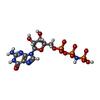+検索条件
-Structure paper
| タイトル | Architecture of the human GATOR1 and GATOR1-Rag GTPases complexes. |
|---|---|
| ジャーナル・号・ページ | Nature, Vol. 556, Issue 7699, Page 64-69, Year 2018 |
| 掲載日 | 2018年4月5日 |
 著者 著者 | Kuang Shen / Rick K Huang / Edward J Brignole / Kendall J Condon / Max L Valenstein / Lynne Chantranupong / Aimaiti Bomaliyamu / Abigail Choe / Chuan Hong / Zhiheng Yu / David M Sabatini /  |
| PubMed 要旨 | Nutrients, such as amino acids and glucose, signal through the Rag GTPases to activate mTORC1. The GATOR1 protein complex-comprising DEPDC5, NPRL2 and NPRL3-regulates the Rag GTPases as a GTPase- ...Nutrients, such as amino acids and glucose, signal through the Rag GTPases to activate mTORC1. The GATOR1 protein complex-comprising DEPDC5, NPRL2 and NPRL3-regulates the Rag GTPases as a GTPase-activating protein (GAP) for RAGA; loss of GATOR1 desensitizes mTORC1 signalling to nutrient starvation. GATOR1 components have no sequence homology to other proteins, so the function of GATOR1 at the molecular level is currently unknown. Here we used cryo-electron microscopy to solve structures of GATOR1 and GATOR1-Rag GTPases complexes. GATOR1 adopts an extended architecture with a cavity in the middle; NPRL2 links DEPDC5 and NPRL3, and DEPDC5 contacts the Rag GTPase heterodimer. Biochemical analyses reveal that our GATOR1-Rag GTPases structure is inhibitory, and that at least two binding modes must exist between the Rag GTPases and GATOR1. Direct interaction of DEPDC5 with RAGA inhibits GATOR1-mediated stimulation of GTP hydrolysis by RAGA, whereas weaker interactions between the NPRL2-NPRL3 heterodimer and RAGA execute GAP activity. These data reveal the structure of a component of the nutrient-sensing mTORC1 pathway and a non-canonical interaction between a GAP and its substrate GTPase. |
 リンク リンク |  Nature / Nature /  PubMed:29590090 / PubMed:29590090 /  PubMed Central PubMed Central |
| 手法 | EM (単粒子) |
| 解像度 | 4.0 - 4.4 Å |
| 構造データ | |
| 化合物 |  ChemComp-GNP: |
| 由来 |
|
 キーワード キーワード | SIGNALING PROTEIN / mTORC1 amino-acid sensing lysosome growth control |
 ムービー
ムービー コントローラー
コントローラー 構造ビューア
構造ビューア 万見文献について
万見文献について







 homo sapiens (ヒト)
homo sapiens (ヒト)